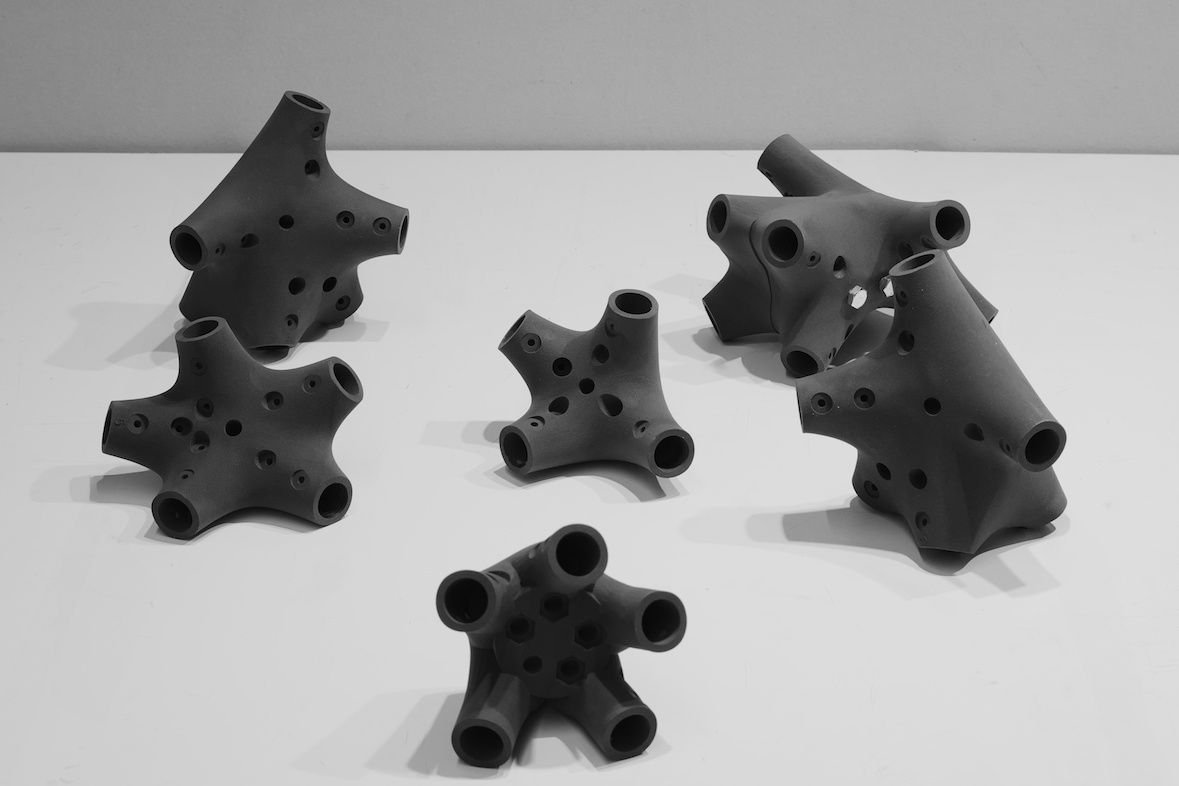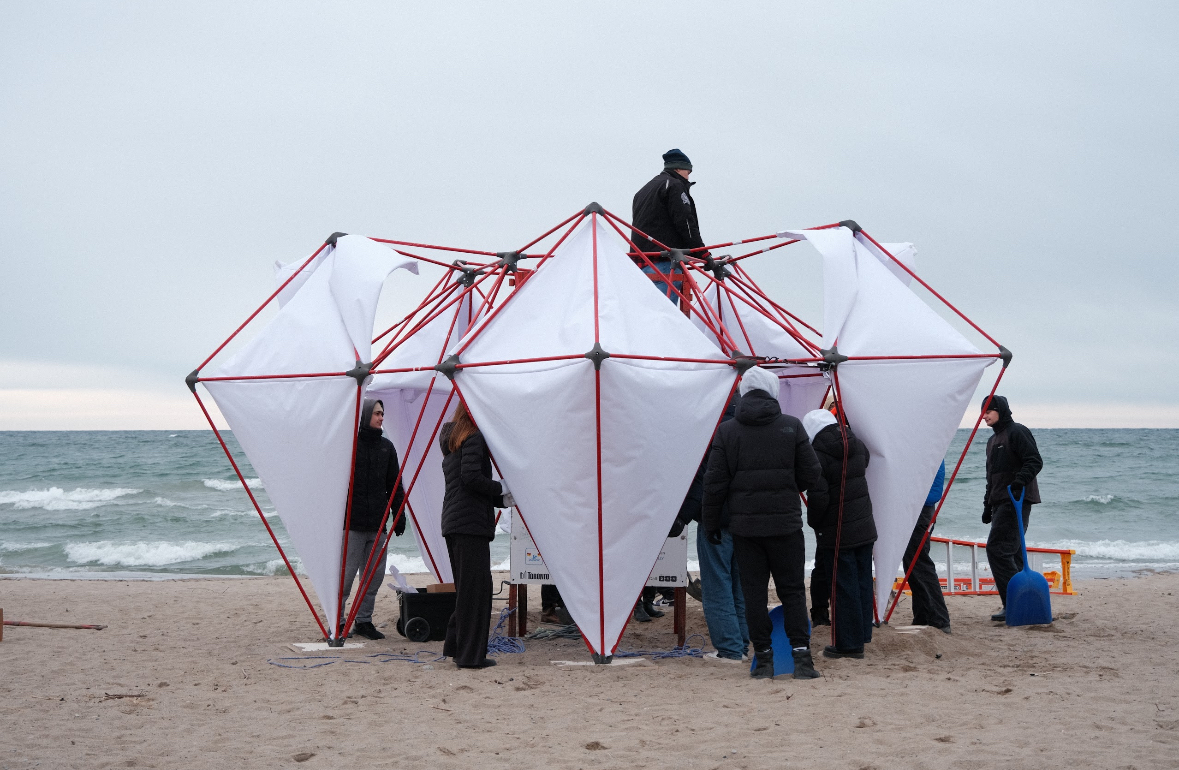Student-Led Innovation Takes Center Stage: NOVA's Journey from Concept to Creation at Winter Stations 2024
In the realm of architectural innovation and creative problem-solving, a group of students embarked on a design-build project called NOVA that seamlessly blends cutting-edge technology with traditional craftsmanship for the 10th anniversary of Winter Stations (external link) . Each year, Winter Stations holds a design competition as part of a public exhibition at Woodbine Beach. The project's first standout feature is the implementation of a bespoke 3D-printed node, a crucial component that intricately connects various pipes, ensuring structural stability. Over a meticulous three-month period, the team conducted rigorous stress and temperature tests on the nylon 3D printed material, guaranteeing its resilience in extreme winter conditions. Utilising tools like Rhinoceros 7 and Grasshopper digital softwares, the team overcame challenges unique to 3D printing that have proven exceptional in real-world environments.
Another compelling facet of this project lies in the team's integration of textile and sewing skills into the architectural design. Motivated by the theme "Resonance," the team extensively researched and tested fabrics. To account for real-world scenarios, such as spills and playful interactions, the team innovatively incorporated textiles on a larger scale, enhancing the aesthetic and functional aspects of their installation. Overcoming construction challenges, they anchored the structure with threaded rod footings and aircraft cables, prioritising safety.
NOVA was installed on the beach within 90 minutes during a snowstorm, a significant improvement from past efforts that took hours. The use of prefabricated parts simplified the process, with a focus on transporting components and swift assembly. Post-installation, the structure garnered attention, with children playing on it and people appreciating the interactive and aesthetic elements, especially the reused lifeguard structure. As the lead designer, undergraduate student Jake Levy drew inspiration from past Winter Stations submissions, incorporating elements from each to evolve the team's approach. Extensive modelling, including real models and AR technologies, allowed the team to visualise and successfully deliver on their vision.The project also prioritised multi-generational knowledge sharing by including first and second-year students, aiming to inspire undergraduates to continue the tradition and build on their learning.
What prompted your involvement with Winter Stations Toronto?
Jake: This is the 10th anniversary of the Winter Stations International Design Competition. Before I came to DAS, I attended Winter Stations; it was a big part of my life growing up in the city. So, it was an honour when I was asked to lead a team of people to design a winter station for its 10th anniversary!
Luca: I was involved as a first year student in the fabrication stage of previous Winter Stations, so being able to design and lead a fabrication process feels like it's given me more of an understanding of how a full project comes into completion and is processed in each of its stages.
Nate: Throughout first and second year studio especially, you go through the whole design process without seeing things truly come to life and materialise, without touching and feeling your project. The opportunity which Winter Stations presents is to create something in your sketchbook and bring it into real life, which forms a significant part of our understanding of how things are built and designed.
Take us through your design process and how the skills you learn at DAS influence your approach.
Jake: This year's theme is "Resonance" - it tasks designers to reimagine an unused lifeguard station in the winter season that reflects the artistic legacy and enduring impact of Winter Stations. Past DAS Winter Stations, including Snowcone, Lithoform and S'winter Station, inspired us. NOVA is a star that has crashed on top of a lifeguard station, illuminating DAS artistic legacy and enduring impact of Winter Stations Woodbine Beach throughout the night! The star pavilion shields users and encourages them to engage with their surroundings, and the lifeguard station makes a beacon for users to access panoramic views of the beach.
Students explored iteration by creating several scaled physical models to create NOVA. Students learned about the forces acting on the structure and how to prevent splaying and shearing. Students learned about the 3D Printing technologies we have at DAS; they incorporated 3D printed nylon into the nodes that connected the electrical conduit - creating a modular prefabricated structure consisting of 7 large nodes with intricate connections and details.
Getting involved is so important! Learning to fabricate at the Camp Winston Paddock design-build in my first year taught me to be precise and accurate. Actively participating in extracurricular design builds helped me confidently execute a successful Winter Stations.
Luca: For design and fabrication, I think it’s important to make scale models to test things out, especially when sourcing or testing different materials - for example, when we decided not to do traditional bolts at the end of the conduit pipes. It's important to see how much structures withstand in terms of weather and stress from people interacting with it. Learning to draw and make sketch models in our studio classes become an integral part of the process and completing a final build project.

What have you learned from this collaborative project and are able to bring to new experiences?
Jake: I’ve learned logistics, time management, and budgeting. Students learn about logistics, whether meeting with manufacturers, suppliers or wholesalers. When purchasing products from businesses, we experience shipping delays, so we must understand that we work with people in different roles, which is essential in this industry.
We’re given a budget, and not surpassing that is essential. We learned how to deliver a great project without going over budget in Project Economics, taught by Jennifer McArthur. Design-builds teach us how to multitask while in school. We are all doing studio and extracurricular activities, travelling to present international research papers, succeeding academically, and producing a great design-build.
I learned how to be a team leader and how to work with people, as well as students from various years. Scheduling, organization and communication skills were essential for me to lead our students, especially as a project lead.
Nate: The number one thing I learned is the application of skills we learn in the classroom; usually when we see our projects in studio we only go so far in the classroom, so design-builds bring our ideas to life and help us work out those little meticulous details - how will this fabric will be cut, how will it be stitched - we don’t ordinarily see this come to fruition in the studio. It simulates what happens within the industry, which is probably the most important thing I've learned.
Luca: It’s really good to have something like this in your portfolio, I think how you communicate and work with a team is really sought after - it takes a lot of communication to bring something into the real world. In the future, when we want to construct buildings, we need to have a good sense of communication and collaboration.
Emily: Looking at the detailing, it got to the point where we were combining fabrics and experimenting with different stitching types to make sure it was both functional and remained true to our vision - in studio we don't have time to get to the nitty gritty and the opposite is the case for Winter Stations. From my personal experience, design-builds close that gap and allow us to put those skills into practice, which is wonderful.
How do you think this makes you a better designer and better relate to your community, a better architect?
Luca: We don't get to see how people interact with what we've designed in the studio because we just create images and drawings. We don't create things which people can see and get up and touch. Bringing a solid object into the world and seeing what people do with it is really important, because then we get the sense of how to create better drawings that are more for the human scale and for people.
Jake: Winter Stations gives students global exposure - we were featured in Archdaily (external link) , Parametric Architecture (external link) , Canadian Architect, The Toronto Star (external link) , and many other news articles in the city, which provides students involved in the project with great exposure and benefits our entry into the AEC community.
Nate: The project creates a great simulation of what a design solution looks like from the ideation, schematic design phase and all the way to the built form. It’s transferable to other design fields, especially architecture. It's almost like stretching your design muscles, and what you learn is carried forward for the rest of your career. It also engages the entire school in exercising those muscles and practising those skills that are transferable and will be used in the future for your career.
Emily: One of the things we usually miss in studio is the element of community, or being able to communicate with the people we are building or designing for - I think it’s pretty neat to be able to see how designs start to interact with the community or what kind of spectacle we can create in such a vast space that can bring ideas to life.
Credits
Project supervised by Associate Chair Vincent Hui
Lead Designer: Jake Levy
Design Team Members: Emily Lensin, Luca Castellan, and Nathaniel Barry
Fabrication Team: Sabeeh Mobashar, Mikayla Burmania, Dean Roumanis, Finn Farrall, Nicholas Kasil, Marko Sikic, Gabriel Boscal, Massimo Montanari, Cici Huang, Cali Cavarzan, Andrew De Lorenzi, Marko Jovanovic, Rachel Kim, Luke Jin, Christine Ho, Samanta Sohail, Henry Chong-Bedrossian, Audrey Babazadeh, Rafaela Sposito, and Kiana Bermudez.
Workshop Contributors: Filip Tisler, Jordan So, and Jason Ramelson
Photography Credits: Dean Roumanis, Gabriel Bocsa, Jake Levy, and Ariel Weiss
Videography: Nicholas Kisil
